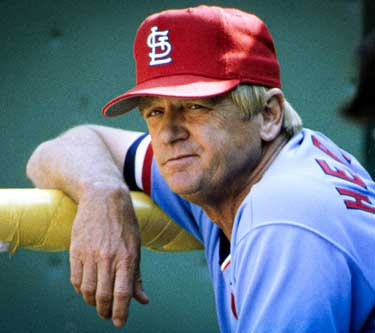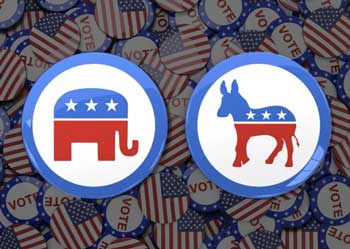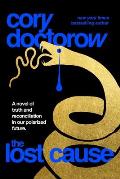Archive: April, 2024
Whitey Herzog

If I ever had anything like a "mentor" in my baseball fandom, it was a guy I never met. He was a former mediocre ballplayer not good enough to be an everyday presence in any big league lineup, but then went on to be a Hall of Fame manager. His name was Whitey Herzog, and he died a few weeks ago at age 92.
Whitey's time as a manager coincided with my formative years as a baseball nerd. He took over the Kansas City Royals of the American League in 1975 and it was around 1976 or ’77 that I became interested enough in the game to start reading box scores and developing favorite players and noticing how different ballparks played and so forth. But I knew nothing of Whitey or managers or strategies then. It wasn't until Whitey got fired by the Royals (after three straight division titles, the fools!) and took over my favorite team, the National League's St. Louis Cardinals, that I started to take notice.
I'd been a fan of the Cardinals for one reason: one of the first games I remember seeing on TV was a Cardinal game in which Lou Brock stole bases. That was cool. Thus, they became my team. They were bad back then, but I don't think I was aware of it in real time. What I remember about my Cardinal fandom from those days was being excited if they were playing the Dodgers (we got Dodger games on our local radio) and feeling good when I'd open up a new pack of baseball cards and find Cardinal players in it. (I have a distinct memory of getting a Lynn McGlothen card with him wearing the pillbox-type white-striped cap I only ever saw on cards, never on TV. Also one of Bake McBride in a regular uniform.)
When the 1980s rolled around, I was more curious about the off-field workings of a team and that's when Whitey—who had become both the field manager and the general manager of the Cardinals, the first person to hold both jobs simultaneously in decades and the last one to do so to date—started dismantling the Cardinal roster. Garry Templeton, the popular All-Star shortstop? Gone, traded. Ted Simmons, the popular star catcher? Gone, traded. Ken Reitz, Leon Durham, Pete Vukovich? Get out of town, boys. It wouldn't be until later that I really knew what was going on, I just thought it was curious that so many guys would be traded away deliberately.
1981 was a strike year. The season just stopped right in the middle, so my attention wasn't what it would be going forward, but it did bum me out that the Cardinals finished second in both halves of what became the "split season" of ’81. But 1982. Now I'm a teen and I'm learning things. I'm reading the "transactions" section of the sports page every day, looking for new moves Whitey was making as the season started, wondering what it meant. This is still the primitive before-times, of course, so following an out-of-market team was a challenge that mostly relied on the daily box scores and the occasional yahtzee of the Cards being featured on Monday Night Baseball or the NBC Game of the Week, as well as Vin Scully's radio play-by-play on those 12 meetings a year between the Cardinals and Dodgers ("A very pleasant good evening to you wherever you may be, I'm Vin Scully, along with Jerry Doggett and Ross Porter, and it's time for Dodger baseball!"). Still, I had my faves. First baseman Keith Hernandez topped the list. Also the guy they'd traded Templeton for, Ozzie Smith. And there was this new guy I'd never heard of named McGee that looked really funny when he batted. And they were good—won 90 games, swept Atlanta in the National League playoffs, and beat Milwaukee in the World Series. And when your team wins the World Series in the first year you're really die-hard paying attention to the ins and outs of the sport, well, that's it for you, you've crossed the Rubicon. Your foundation as a fan has been set, and in my case it was set with Whiteyball.
Whitey looked at his environs, first in Kansas City, then in St. Louis, and noted the artificial turf and big outfields. I can use this, he thought, and favored speedy guys and defensive stars in KC with Willie Wilson and Frank White and company. In St. Louis, he had total control and didn't just favor such players, he went out and got them from other teams and had no trouble dealing away players who didn't fit his vision. And the Cardinals became a revelation to the league, winning games left and right by stealing bases, manufacturing runs, making defensive plays, and treating the home run like a deterrent more than an actual weapon—so long as you had one guy in the lineup who would pop one every now and then, the pitcher had to worry about it, and that was enough.
The ’82 Cardinals won it all with their top home run threat, George Hendrick, hitting just 19 longballs, good for 17th in the 12-team National League. As a team they hit all of 67, dead last in the NL. But they were first in on-base percentage, first in most defensive metrics, and stole 200 bags, far and away more than any other club. To me, that's a far more exciting way to play and to watch baseball.
I was a devotee. To this day, my favorite team of all time is the 1985 Cardinals, the team that most successfully embodied the Whiteyball philosophy. Though Whitey was no longer the GM—he stepped down from that post prior to the ’83 season—he still held a lot of clout with the front office and made that ’85 club league champs (101 wins). They had the Rookie of the Year in a scrawny outfielder named Vince Coleman who stole 110 bases. They had the NL MVP in Willie McGee, who hit .353 and stole 56. They had Gold Gloves at center field and shortstop, plus future Gold Glove winners at third base and right field; the Cy Young runner-up in a great year for pitchers plus a second starter with 20 wins; and stole not 200 bases like the ’82 team did, but 314 (league average of the other 11 NL clubs: 120). Second baseman Tommy Herr drove in 110 runs while hitting just eight homers. That team was awesome, and that team was Whitey Herzog baseball. (Except for Jack Clark. He was the first baseman, acquired in a preseason trade to fill the gaping void that had been made when Keith Hernandez was traded in ’83 because of off-the-field behavior, and though Clark was critical to the team, it was in the function of the deterrent. He didn't fit the Whiteyball mold at all—not a good defender, not fast, not a "fundamentals first" kind of guy—but he could hit and he could hit them out on occasion, giving the team their one power threat and often an extra baserunner. Pitchers would often pitch around Clark and he drew a lot of walks, both intentional and the sort of "intentionally unintentional" type. Which was just fine with Andy Van Slyke, who usually batted behind him.)
When I moved out on my own and came up to Seattle and started going to Mariner games at the Kingdome, my season-ticket mates Erik and Mike, in a clever melding of my Herzog allegiance and my status as cat-guardian, dubbed my preferred brand of baseball "Harr-ball." It was often frustrating to watch the M's in those days, even when they were winning, because they won with boppers. Very little Harr-ball to be found.
These days, even in the less-homer-friendly outdoor venue the M's now call home, not only is there still a dearth of Harr-ball, there's a lack of basic managerial smarts and strategy that makes me miss Whitey Herzog on a near-everyday basis.
Whitey Herzog didn't make me a baseball fan. But he did make me the kind of fan I am. And I'm grateful. RIP, Whitey.

One of these things is not like the other

A while back I made reference here to what I call the "battered spouse contingent" of the Republican party. I was subsequently asked what I meant by that, and it's pretty simple—people who continue to vote Republican despite the fact that Republican policies have hurt them repeatedly. That wasn't readily accepted as valid by my questioner, and in the interests of civility I didn't press the point overly much.
This individual reminded me a lot of people I've known over the years that have espoused sentiments like, "it doesn't matter who wins [a presidential election] because they're all the same." Or, "I voted for [third-party candidate] because s/he's the only one that I agree with," or for reasons of protest over the two-party system.
The "they're all the same" garbage seemed to peak (in my lifetime, anyway) in the 2000 campaign between George W. Bush and Al Gore. We can thank Ralph Nader for a lot of that. But regardless of the why, the result of people thinking like that was a GWB administration that began with corruption of the energy industry (Enron, anyone?), then 9/11 shocked the president despite his having been warned well in advance that something like it was being planned, then the response to 9/11 changed the world for the worse for decades.
They were not remotely the same.
While it's not as prevalent as it was in 2000, the idea that there's little to no difference between the parties is still espoused by a not insignificant percentage of Americans. Most of this is out of ignorance, some willful some not, but today the idea is being pushed indirectly by the Republican party—because if everyone is corrupt, then who cares that so many Republicans are? The Trumpification of the GOP has us more polarized than ever, but the parties have been starkly different for a long time. People who are not political junkies like me just don't know it.
So I had this idea to put together a little snapshot of how the country did under the last several presidents, something that would be easy to digest. Kind of like the back of a baseball card, with the important stats and facts laid out in black and white. (While my formal education in American history is limited to some University survey courses, I am a bit of a history nerd and know a thing or two from study and from having lived through time with my eyes and ears open.) And then I heard Buzz Burbank on The Bob Cesca Show joke about how we need a "pamphlet drop" to remind people about everything from 2016-2021, and I started expanding the thought.
In putting that idea into form, I found it isn't practical to just list economic stats and global crises if you want to convey the performance of an administration. You need more information. But I've endeavored to find a middle ground between back-of-the-baseball-card and pages-in-an-encyclopedia to show at a relative glance how the country fared under different administrations.
So, parameters:
Firstly, to my knowledge and judgment, the last Republican president who was worthy of holding the office—that is, who took his oath the the Constitution seriously, who actively worked for the benefit of the people as a whole, who didn't commit or abet crime or corrupt practices, and who wasn't otherwise overtly doing harm for his own purposes—was Dwight Eisenhower, POTUS No. 34, whose term ended in 1961. (One could make an argument for Ford, but he wasn't elected as either POTUS or VP and that pardon... No. The pardon is a disqualifier.) In Ike's time, the Republicans were a centrist party that balanced a belief in free-market capitalism with the needs of the populace, were staunchly anti-Communist and saw the US as a global force for freedom and democracy, and were happy to maintain the social status quo. Since then we can see a steady decline from that to today's autocratic, anti-democracy, isolationist, corruptly fascist Republicans, with mileposts along the way in Richard Nixon, Henry Kissenger, Ronald Reagan, Newt Gingrich, Dick Cheney, Mitch McConnell, all the way to Trump and his Trump Sycophants.
So we begin with Ike's successor, John F. Kennedy, in 1961, and examine several items for each administration: economic indicators, military conflicts, scandals, global or national crises, notable staff, important achievements or policies, and Supreme Court appointments. I wrap each one up with a brief(ish) few paragraphs of context, keeping things to a single page (though I did have to adjust my typesetting format a few times to make that work). It's a remarkably even split between the two parties in power—in those 64 years, there have been six Democratic presidents and six Republican presidents, each covering a total of 32 years (including 2024).
But before getting into the individuals, here's a composite back-of-the-card snapshot.
DEMOCRATS (8 TERMS)Total budget deficit increase: (–$2.716 trillion) Major wars: 2, 1 inherited |
REPUBLICANS (8 TERMS)Total budget deficit increase: $3.338 trillion Major wars: 4, 1 inherited |
Republicans added three and a third trillion dollars to the deficit, Democrats recovered over two and two-thirds trillion of it despite the handicap of having to pay all that interest on Republican debt. Republicans gave us almost seven years of recession to the Democrats' one and a quarter (more than half of which was recovering from The Great Recession of G.W. Bush). Tell me again how the Republicans are the fiscally responsible ones.
Anyway, here's the completed project. I plan on distributing it to some podcasters I like in hopes they will make it available to their audiences in hopes that members of those audiences will share it with folks they know and in an ideal world it "goes viral." Not really expecting that, based on my history in trying to promote things on the Internet, but we'll see.
Feel free to spread this around, everybody.
1 Comment

